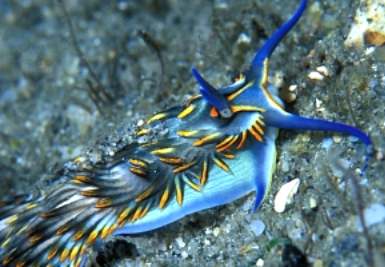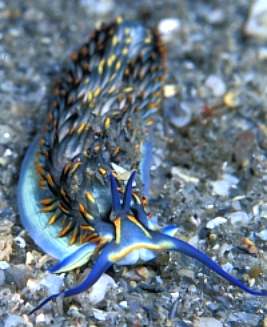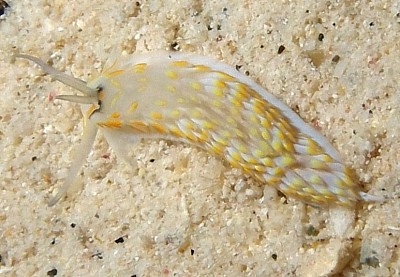

Cerberilla sp. 7
Order: NUDIBRANCHIA
Suborder: AEOLIDINA
Family: Aeolidiidae
PHOTO
West Palm Beach, Florida, USA. Depth: 15 feet. Size: Approx. 3/4 inch April 30, 2003. Photo: Jeff Hutchinson
This is an apparently unnamed species of Cerberilla from the Caribbean. A second Caribbean species on the Forum is considered to be Cerberilla tanna but the identity of that species remains problematic.
Authorship detailsRudman, W.B., 2004 (February 9) Cerberilla sp. 7 [In] Sea Slug Forum. Australian Museum, Sydney. Available from http://www.seaslugforum.net/find/cerbsp7
Related messages
Re: Cerberilla sp. 7 from Bonaire, Caribbean
September 29, 2009
From: Michael McVicar


Concerning message #22668:
Dear Bill,
Likewise, I've found an unusual sea slug on Bonaire on my trip there August 2009. The colour is different from the one posted by Lureen but otherwise appears similar.
I'd found this one under the Salt Pier on Bonaire on a night dive, moving about in the open on the sand.
Locality: Salt Pier, 15 feet, Bonaire, Netherland Antilles, Caribbean, 19 August 2009, on bare sand below pier pilings. Length: 0.75 inches. Photographer: Michael McVicar.
Michael McVicar
mike.mcvicar@ontario.ca
McVicar, M.J., 2009 (Sep 29) Re: Cerberilla sp. 7 from Bonaire, Caribbean. [Message in] Sea Slug Forum. Australian Museum, Sydney. Available from http://www.seaslugforum.net/find/22673
Dear Mike,
Your animal is certainly a species of Cerberilla and I suspect it is the same as Lureen's but lacking the blue pigmentation. Certainly the yellow pigmentation and the black line on the head are identical. Perhaps it is a juvenile which has not yet developed the blue colouration? We know so little about these species at present, but hopefully as more photos like yours and Lureen's become available, it will all become clearer
Best wishes,
Bill Rudman
Cerberilla sp. 7 from Bonaire, Caribbean
September 24, 2009
From: Lureen Ferretti


Dear Bill
This interesting nudi was just out scooting around in the sand. My dive buddy Karin Hall pointed found him and pointed it out to our group. It looks the same as Mr Hutchinson photographed [message #9858].
Locality: Windsock Beach, 15', Bonaire, Netherland Antilles, Atlantic Ocean, 13 September 2009, before the sand meets the dropoff. Length: 1". Photographer: Lureen Ferretti.
Lureen Ferretti
Reenyb@comcast.net
Ferretti, L., 2009 (Sep 24) Cerberilla sp. 7 from Bonaire, Caribbean. [Message in] Sea Slug Forum. Australian Museum, Sydney. Available from http://www.seaslugforum.net/find/22668
Dear Lureen,
Yes this is certainly the same as the earlier photos from Florida. It is a species of the aeolid genus Cerberilla, which spend much of their lives burrowing in sand. At the time of the earlier message, Cerberilla tanna was the only species of Cerberilla known from the Caribbean. We now know there are other species including this spectacularly coloured one which I am calling Cerberilla sp 7 on the Forum.
Best wishes,
Bill Rudman
Cerberilla sp. 7 from St. Vincent
November 1, 2005
From: Les Wilk

Hi Bill;
This is the species that Humann & Deloach called the "gold-fringed nudibranch", Cerberilla sp. The photo in their Reef Creatures book was also taken in St. Vincent. This is apparently the same as the one you called Cerberilla sp. 7, from West Palm Beach, Florida. I wonder if it's been reported from any other locations.
Locality: Joyce's Nursery dive site, St. Vincent Is., Caribbean. Depth: 15 feet. Length: 1 inch. July 2005. sand/muck bottom. Photographer: Keri Wilk
Les Wilk
wilk@reefnet.ca
Wilk, L., 2005 (Nov 1) Cerberilla sp. 7 from St. Vincent. [Message in] Sea Slug Forum. Australian Museum, Sydney. Available from http://www.seaslugforum.net/find/15074
Dear Les,
Yes this is the Forum's Cerberilla sp. 7. I don't know of other records, but species of Cerberilla are probably more common than we think, as they spend most of their life buried in the sand so are seldom visible.
Best wishes,
Bill Rudman
Re: Cerberilla tanna? from Florida
May 7, 2003
From: Dave Behrens
Hi Bill:
Jeff's photo is definitely the same species shown in Paul Humann and Ned Deloach's second edition of Reef Creature Identification. Paul asked me to confirm the identifications in this edition which includes almost twice the number of species as his first edition. Like you, I could make no recommendation on the name, because of the Marcus' cursory orginal description. Hard for me to see similarities between Linda's critter and this one, but who knows. As you say - need to see the radula.
Dave Behrens
info@seachallengers.com
Behrens, D., 2003 (May 7) Re: Cerberilla tanna? from Florida. [Message in] Sea Slug Forum. Australian Museum, Sydney. Available from http://www.seaslugforum.net/find/9877Thanks Dave,
Working on the assumption that Linda's animal is much smaller than Jeff's, the reason I suspect they are the same species is that the black markings around the head of Linda's animal persist in Jeff's, and as we can see in Cerberilla incola black spots on the cerata can change into a pair of black lines. There is also another reason I suspect they're the same. If I found 2 specimens of Cerberilla at the same place, in the same week, I would need very good reasons to consider them different species - after all, to echo the cladists, it is the most parsimonious solution.
Best wishes,
Bill Rudman
Cerberilla tanna? from Florida
May 6, 2003
From: Jeff Hutchinson


Dear Dr. Rudman,
I am sending you two photos of a
Cerberilla sp. from Florida that I took yesterday morning. This nudibranch was found on a sandy bottom during the day. A fast mover with rhinophores sweeping the bottom ahead, this nudibranch was observed to suddenly stop and then proceed to bury itself into the sand. Specimen was approx. 3/4 " when fully extended. After many years of diving in the area, this was a first sighting. Only reference that matches specimen was found in Humann's Reef Creature Guide.
West Palm Beach, Florida, USA
Depth: 15 feet. Size: Approx. 3/4 inch April 30, 2003. Photographed by: Jeff Hutchinson
Can you identify it?
Thank you very much
Jeff Hutchinson
Ft. Lauderdale, Fl, USA
bouncedvr@attbi.com
Hutchinson, J. , 2003 (May 6) Cerberilla tanna? from Florida. [Message in] Sea Slug Forum. Australian Museum, Sydney. Available from http://www.seaslugforum.net/find/9858Dear Jeff,
This is a very interesting find. I only know of one speies of Cerberilla being reported from the Caribbean region and that is Cerberilla tanna. Unfortunately, like many of the species described by the Marcuses, it was desribed from a preserved specimen so we have no information on its living colour. Anatomically species of Cerberilla are quite similar to each other, bbut it might be poossible to match their description of the shape of the radular teeth. Your animal has a very impressive colour pattern. Species of Cerberilla are probably much more common than we think, but because they spend most of their time buried in soft sediments, such as sand, we don't often see them. I guess we can call your animal Cerberilla cf. tanna until the radula of a known live animal an be matched with the original description.
It is possible that Linda Ianello's animal from the same location is a juvenile, but we would need an animal intermediate in colour before we could confidently say so. My copy of Paul Humann's book doesn't have a Cerberilla in it, so I would be interested to know what he says, and what his animal looks like. Thanks again for a very interesting find.
Best wishes,
Bill Rudman
